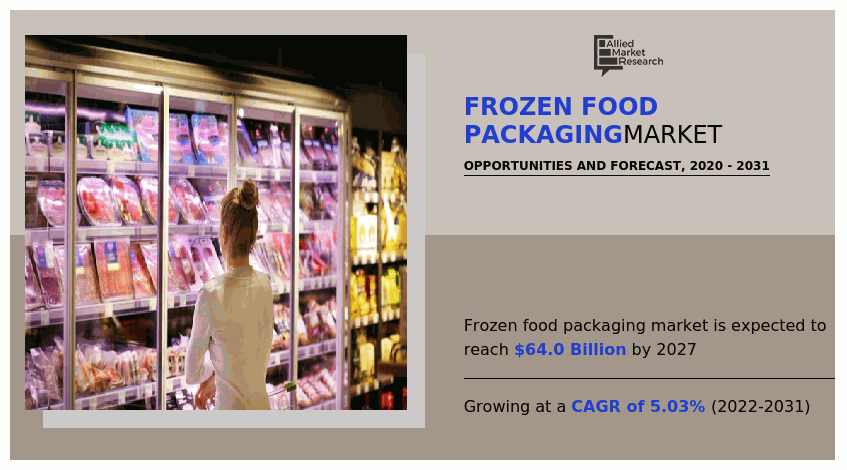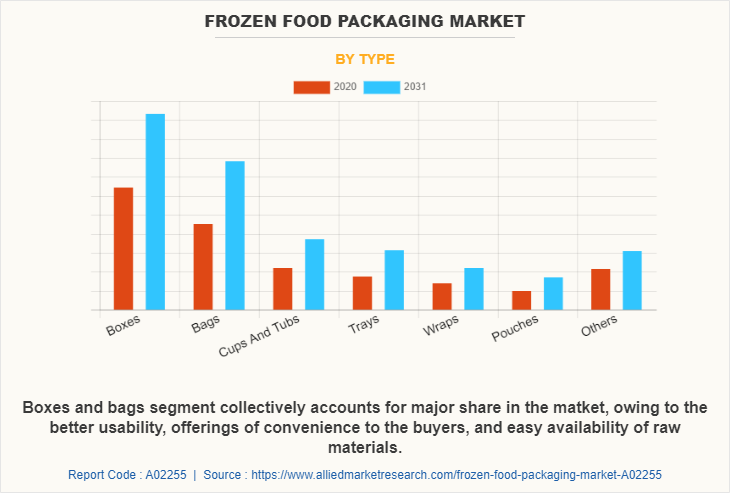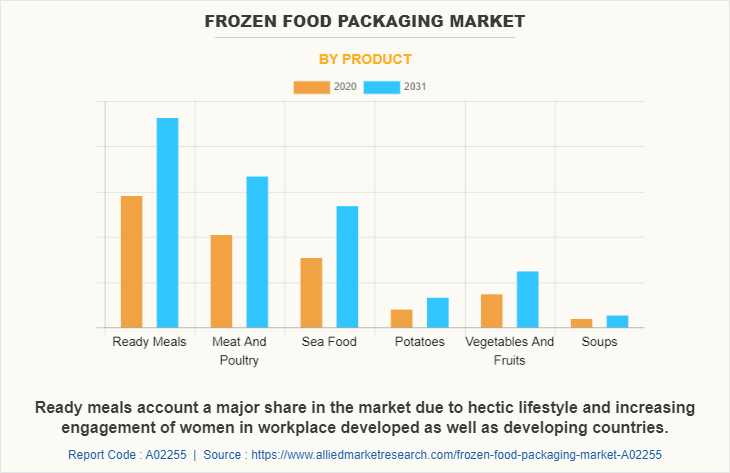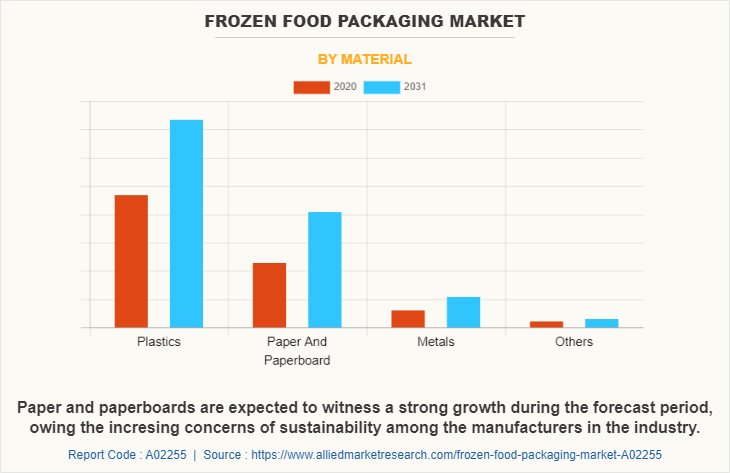Frozen Food Packaging Market Research, 2031
The global frozen food packaging market was valued at $38,826.20 million in 2020, and is projected to reach $63,980.50 million by 2031, growing at a CAGR of 5.03% from 2022 to 2031.
The rapid growth in urbanization and fast-paced lifestyle have shifted the preferences of consumers towards frozen food products, which requires less time for cooking than the traditional home cooked meal. Increase in female participation in the workforce and changes in family dynamics have increased the consumption of frozen food, thus fuelling the growth of the market. Moreover, rise in “on-the-go” consumer base and growth in purchasing power in emerging economies, such as India, and China, further boost the market. Rise in demand for attractive, innovative, and convenient-to-carry packaging for differentiating the product from the rest is also expected to increase market demand.

Market Dynamics
Rise of women participation in the labour force in emerging markets drives the need for convenience foods and beverages. Eating alone at work place at non-fixed mealtimes is becoming more common, due to changed eating habits, attitude toward cooking, and busy lifestyles. Thus, lack of time and change in family dynamics have led to higher consumption of frozen ready meals, as they require less preparation time as compared to cooking meals at home. Moreover, sufficient availability of packaged ready-to-eat foods, bakery, and desserts in the food service industry fuels the growth of the frozen food packaging market size.
The Asia-Pacific market is undergoing transition from traditional homemade cooked meals to frozen food, due to rise in number of female working population. Growth in popularity of fast-food chains, especially in India, China, Thailand, Vietnam, and others fuels the demand for frozen meat, seafood, vegetables, fruits, and potatoes as compared to the developed markets, which further boosts the growth of the frozen food packaging industry. Emerging economies, thus, possess high potential for the expansion of the of the market, thereby, driving the market growth. Swift economic growth, increase in incomes, and busy life style enforce consumers to adopt frozen foods, as individuals begin to prioritize convenience over price. Thus, surge in disposable incomes among individuals, particularly in the developing economies, such as India, and China, further propels the of the frozen food packaging market growth.
However, lower sales of frozen food in various developing countries due to negative consumer perception of packaged foods and low market penetration impede the market growth. Freezing food items is a safety measure taken to preserve food for longer duration. During the process of freezing, ice crystals are formed in food products, which affects the food structure and food efficacy. This in turn, has a negative effect on consumers buying option, leading to change in the perception towards frozen food. In addition, frozen food is perceived as less nutritious as compared to fresh food. Furthermore, the addition of preservatives and other chemicals is perceived as a negative trait in frozen food ecosystem. All these factors lower the sales of frozen foods, thereby, restraining the growth of the market.
Segment Overview
The frozen food packaging market is segmented on the basis of type, product, material, and geography. On the basis of type, the market is divided into boxes, bags, cups & tubs, trays, wraps, pouches, and others. On the basis of product, it is classified into ready meals, meat & poultry, seafood, potatoes, vegetables & fruits, and soups. On the basis of material, the market is categorized into plastics, paper & paperboards, metals, and others (glass and wood). On the basis of geography, the market is analysed across North America, Europe, Asia-Pacific, and LAMEA.

By Type
The frozen food packaging market mainly composes of boxes, bags, cups & tubs, trays, wraps, pouches, and others. Boxes accounts for major market share in terms of revenue and volume, followed by bags and trays. Bags are expected to witness fastest growth rate during the frozen food packaging market forecast period.

By Product
By product, the ready meals segment is leading the frozen food packaging market share. However, the vegetables and fruits segment is the fastest growing segment owing to increased advancements in technologies and improved R&D among food manufacturers. Asia-Pacific and Europe collectively accounted for about 50% of share of the market in 2021.

By Material
By material, the paper and paperboard segment dominate the market. However, metals segment is anticipated to be the fastest growing segment during the forecast period.
Competitive Analysis
The key players profiled in the report include Amcor Ltd., Ball Corporation, Bemis Company, Inc., Crown Holdings, Inc., Graphic Packaging International, Inc., International Paper Company, Pactiv LLC, Sealed Air Corporation, Sonoco Products Company, and WestRock Company. The other key market players (not profiled in this report) in the value chain include American Packaging Corporation, Berry Plastics, Caraustar Industries, CM Packaging, Emmerson Packaging, Flair Flexible Packaging Corporation, Graham Packaging Company Huhtamaki N.A., LINPAC Group, and Sabert Corporation.
Key Benefits For Stakeholders
- This report provides a quantitative analysis of the market segments, current trends, estimations, and dynamics of the frozen food packaging market analysis from 2020 to 2031 to identify the prevailing frozen food packaging market opportunities.
- The market research is offered along with information related to key drivers, restraints, and market opportunity.
- Porter's five forces analysis highlights the potency of buyers and suppliers to enable stakeholders make profit-oriented business decisions and strengthen their supplier-buyer network.
- In-depth analysis of the frozen food packaging market segmentation assists to determine the prevailing market opportunities.
- Major countries in each region are mapped according to their revenue contribution to the global market.
- Market player positioning facilitates benchmarking and provides a clear understanding of the present position of the market players.
- The report includes the analysis of the regional as well as global frozen food packaging market trends, key players, market segments, application areas, and market growth strategies
Frozen Food Packaging Market Report Highlights
| Aspects | Details |
| By Type |
|
| By Product |
|
| By Material |
|
| By Region |
|
| Key Market Players | GRAPHIC PACKAGING INTERNATIONAL, INC, PACTIV LLC, SEALED AIR CORPORATION, INTERNATIONAL PAPER COMPANY, WESTROCK COMPANY, BEMIS COMPANY, INC., Ball Corporation, CROWN HOLDINGS, INC., Sonoco Products Company, Amcor Ltd. |
Analyst Review
Frozen food products are packaged in boxes, bags, cups & tubs, trays, wraps, pouches, and others to extend shelf life, maintain nutritional content, and for convenient use. These packages are made of plastics, paper & paperboard, metals, glass, and wood, which provide high resistance to abrasion and reduce damage due to vibration, impacts, and shocks during transportation.
Europe is the largest market for frozen food followed by North America, occupying the second position, with significant demand for ready meals and meat products. This leads to a consistent growth of frozen food packaging in these regions. Whereas, the Asia-Pacific market is undergoing transition from traditional homemade cooked meals to frozen food. This is due to the rise in number of females working outside home. Moreover, growth in popularity of fast food chains, in India, China, Thailand, Vietnam, and others, creates a huge demand for frozen meat, seafood, vegetables, and fruits, which in turn, drives the growth of the frozen food packaging market. Also, rise in prices and insufficient supply of fresh food in Middle East countries, such as Egypt, Saudi Arabia, UAE, Iran, and others is the primary factor leading to the higher consumption of frozen food, which accelerate the market growth.
Innovative packaging solution, such as hanging holes, sealable zippers, tear notch, and others for product differentiation are anticipated to have a positive impact on the market growth.
The global frozen food packaging market was valued at $38,826.20 million in 2020, and is projected to reach $63,980.50 million by 2031
The global Frozen Food Packaging market is projected to grow at a compound annual growth rate of 5.03% from 2022 to 2031 $63,980.50 million by 2031
Sonoco Products Company, INTERNATIONAL PAPER COMPANY, Ball Corporation, CROWN HOLDINGS, INC., SEALED AIR CORPORATION, PACTIV LLC, WESTROCK COMPANY, BEMIS COMPANY, INC., Amcor Ltd., GRAPHIC PACKAGING INTERNATIONAL, INC
Based on region, Europecontributed the highest share in 2020
Rise in urbanization, fast-paced lifestyle, increase in female participation in the workforce, rise in “on-the-go” consumer base, and growth in purchasing power in emerging economies drive the growth of the global frozen food packaging market.
Loading Table Of Content...



